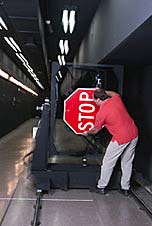New NIST Facility Soon Will Be ‘Reflecting’ on Safer Signs

© R. Rathe
Our roadways should get safer in the future, now that the National Institute of Standards and Technology (NIST) has developed a way to accurately and reliably measure how light reflects off stop signs and other road markings.
Road signs and markings are designed to be visible at night by retroreflectivity—that is, they reflect some of the light emitted by a vehicle’s headlights back toward the driver’s eyes. However, measurements of retroreflectivity have varied so much among different devices and laboratories that federal transportation officials have been unable to define minimum standards for this Congressionally mandated characteristic.
Recently, NIST established a facility—funded by the Transportation Research Board of the National Cooperative Research Program—that resolves numerous measurement problems and improves accuracy. Inside the facility, one finds a long black tunnel with a set of tracks on which sits an instrumented platform. Signs or materials are mounted on the platform, which can be moved 3 to 30 meters (10 to 100 feet) from a light source at one end of the tunnel. Using custom software, scientists precisely control all of the components and measure the characteristics of light reflected from the sign to a detector located close to the source.
NIST expects that the facility will begin providing calibration services early in 2004.
Media Contact
More Information:
http://www.nist.gov/public_affairs/techbeat/tb2003_0811.htm#signsAll latest news from the category: Transportation and Logistics
This field deals with all spatial and time-related activities involved in bridging the gap between goods and people, including their restructuring. This begins with the supplier and follows each stage of the operational value chain to product delivery and concludes with product disposal and recycling.
innovations-report provides informative reports and articles on such topics as traffic telematics, toll collection, traffic management systems, route planning, high-speed rail (Transrapid), traffic infrastructures, air safety, transport technologies, transport logistics, production logistics and mobility.
Newest articles

NASA: Mystery of life’s handedness deepens
The mystery of why life uses molecules with specific orientations has deepened with a NASA-funded discovery that RNA — a key molecule thought to have potentially held the instructions for…

What are the effects of historic lithium mining on water quality?
Study reveals low levels of common contaminants but high levels of other elements in waters associated with an abandoned lithium mine. Lithium ore and mining waste from a historic lithium…

Quantum-inspired design boosts efficiency of heat-to-electricity conversion
Rice engineers take unconventional route to improving thermophotovoltaic systems. Researchers at Rice University have found a new way to improve a key element of thermophotovoltaic (TPV) systems, which convert heat…



